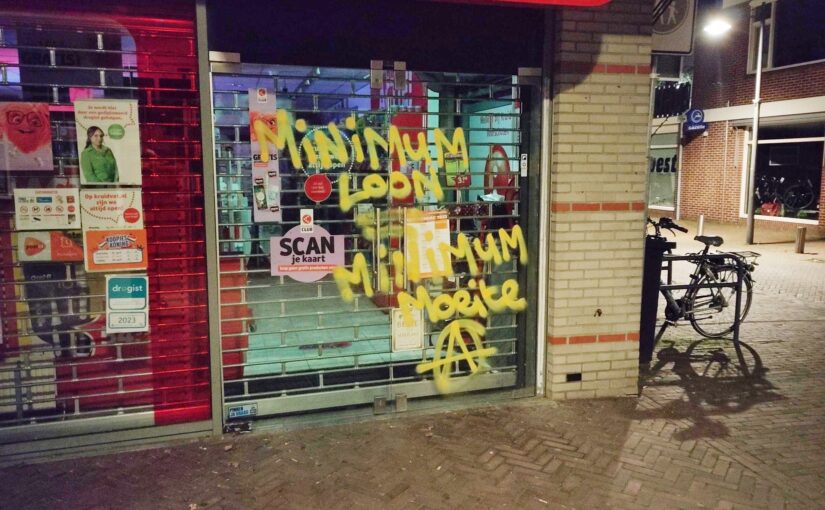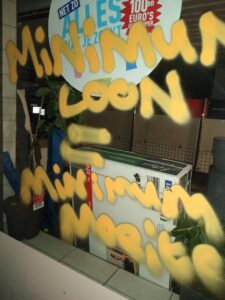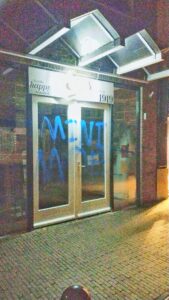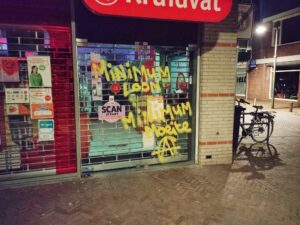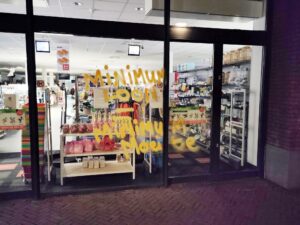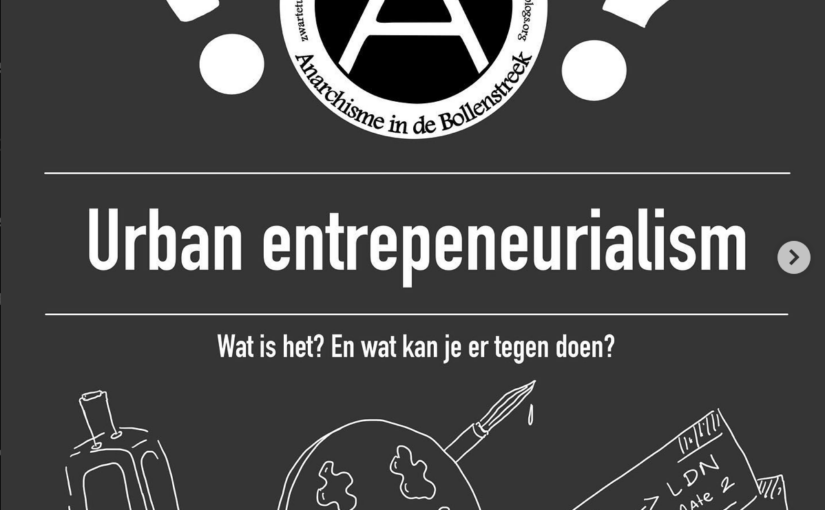infographic: https://www.instagram.com/p/Cqnc426IIWg/
Alt-Tekst
Slide 1:
Urban entrepeneurialism:
Wat is het en wat kan je er tegen doen?
Slide 2:
De term ‘urban entrepeneurialism’ is opgegooid door David Harvey, een marxistische sociale wetenschapper, om een bepaalde vorm van neoliberale beleidsvoering dat zich in de laatste decennia heeft ontwikkeld aan te duiden.
Deze beleidsvoering legt de focus op ‘stedelijke ontwikkeling’ en het creëren van banen. Dit is in tegenstelling tot de beleidsvoering in de periode voor ‘urban entrepeneurialism’, waarbij er met name werd gefocust op het leveren van diensten en faciliteiten aan de belastingbetaler.
Lokale overheden zijn naar buiten gaan kijken. Ze zijn met elkaar aan het concurreren over banen (oftewel bedrijven), investeringen en toeristen.
De eigen belastingbetaler is niet langer belangrijk in de ogen van de lokale overheden.
Slide 3:
‘Urban entrepeneurialism’ komt uiteindelijk dus neer op een bepaalde norm binnen de bureaucratie in stedelijke overheden. Het is een bepaald soort bestuurscultuur welke totaal geen oog meer heeft voor de belastingbetaler en de werkende klasse.
Elke lokale overheid heeft tegenwoordig wel iets van deze bestuurscultuur in zich. Elke lokale overheid probeert zich te specialiseren en te profileren om op die manier zichzelf te verkopen aan investeerders, bedrijven en toeristen.
“De Bollenstreek” profileert zich als paradijs voor bloementelers.
Leiden profileert zich als de Bioscience-stad met een soort silicon valley van pharma- en technologie-bedrijven.
Dit alles wordt geadverteerd als zijnde voordelig voor iedereen die in het gebied woont. de overheid “investeert” in jouw toekomstige baan. De overheid “investeerd” in jouw leefomgeving.
Maar in werkelijkheid ziet de werkende klasse er niks van terug. Al het geld wat uit deze projecten binnenkomt wordt weer aan nieuwe uitgegeven onder het mom van “economische groei” of verdwijnt in de zakken van corrupte bureaucraten en hun vrienden. Dit terwijl het lokale buurtcentrum in de rekeningen verdrinkt.
Slide 4:
Een concreet voorbeeld
Vaak maken lokale overheden gebruik van een “vlaggenschip”.
Dit is een project waar alle marketing en propaganda op gecentreerd wordt. Dit is de ‘unique selling point’. Vaak is dit een kunstzinnig of entertainend project gericht op toeristen. Het doel is om eerst toeristen aan te trekken. Als het toerisme toeneemt, trekt dat hotels en andere toeristische bedrijven aan. Vanaf dit punt komt een wijd arsenaal van grootkapitaal een kijkje nemen.
Deze “vlaggenschepen” zijn dus de kanarie in de koolmijn.
Slide 5:
En een voorbeeld hiervan is “To Breathe” in Leiden.
Het richt zich op toeristen.
Het probeert de “rijke en verbindende Leidse geschiedenis” te verkopen.
Dat de lakenhandel in Leiden nauw verbonden is met de koloniale geschiedenis wordt toevallig niet vermeld.
Ook wordt de lokale bevolking genegeerd. Ze worden niet in de besluitvorming betrokken noch worden lokale kunstenaars ingehuurd om het kunstwerk vorm te geven. In plaats daarvan wordt een high-class bourgeois kunstenares ingehuurd omdat zij al meer aanzien heeft op internationaal niveau en dus de concurrentie-positie van de stad verbeterd.
Slide 6:
Kortom, de stad wordt niet ontwikkeld en verrijkt.
De stad en de lokale bevolking wordt verkocht.
De bureaucraten en kapitalisten worden verrijkt.
Slide 7:
Wat kun je er tegen doen?
Het is met name belangrijk deze “vlaggenschepen” te herkennen wanneer ze in ontwikkeling zijn. Een vlaggenschip is nog een enkel project wat relatief makkelijk te stoppen valt door middel van inspraak, demonstraties en directe acties.
Als het proces van gentrificatie en toename in toerisme eenmaal op gang is wordt het veel moeilijker dit te stoppen.
tegen het grootkapitaal strijden is moeilijk, dus het is beter te voorkomen dat het ooit voet aan de grond krijgt.
Een kunstwerk kunnen we nog saboteren.
Een compleet Bio-science park van de kaart vegen wordt wat moeilijker.
Als jij tips hebt voor ‘urban entrepeneurialism’ tegengaan wanneer het al in een verder stadium is, laat het ons weten in de comments.
(En neem deze kennis ook mee als je zelf op vakantie gaat en zelf de toerist bent)
Slide 8:
Dit was natuurlijk een klein beetje gesimplificeerd, dus… voor meer leesvoer check de website!
Bronnen:
DH_UE
https://libgen.rs/scimag/10.1680%2Fudap.2009.162.3.101
English:
Slide 1:
Urban entrepeneurialism:
What is it? And what can you do against it?
Slide 2:
The term “urban entrepreneurialism” was coined by David Harvey, a Marxist social scientist, to denote a particular form of neoliberal policymaking that has developed in recent decades.
This policy puts the focus on ‘urban development’ and job creation. This is in contrast to pre-urban entrepreneurialism policies, which focused primarily on providing services and facilities to taxpayers.
Local governments have started looking outwards. They are competing with each other for jobs (i.e. businesses), investments and tourists.
The local taxpayer is no longer important in the eyes of local governments.
Slide 3:
Urban entrepeneurialism ultimately boils down to a certain standard within the bureaucracy of urban governments. It is a certain kind of governance culture that completely ignores the taxpayer and the working class.
Every local government nowadays has something of this administrative culture in it. Every local authority tries to specialize and profile itself in order to sell itself to investors, companies and tourists.
“De Bollenstreek” presents itself as a paradise for flower growers.
Leiden presents itself as the Bioscience city with a kind of silicon valley of pharmaceutical and technology companies.
All of this is advertised as being beneficial to anyone living in the area. the government “invests” in your future job. The government “invests” in your environment.
But in reality, the working class sees nothing in return. All the money that comes in from these projects is spent on new ones under the guise of “economic growth” or disappears into the pockets of corrupt bureaucrats and their friends. This while the local community center is drowning in bills.
Slide 4:
A concrete example
Often local government uses a “flagship-project”.
This is a project on which all marketing and propaganda is centered. This is the unique selling point. Often this is an artistic or entertaining project aimed at tourists. The goal is to attract tourists first. When tourism increases, it attracts hotels and other tourism businesses. From this point on, a wide arsenal of big business comes to take a look.
These “flagships” are therefore the canary in the coal mine.
Slide 5:
And an example of this is “To Breathe” in Leiden.
It focuses on tourists.
It tries to sell the “rich and connecting history of Leiden”.
Coincidentally, the fact that the cloth trade in Leiden is closely linked to colonial history is not mentioned.
The locals are also ignored. They are not involved in the decision-making nor are local artists hired to design the artwork. Instead, a high-class bourgeois artist is hired because she already has more prestige on an international level and thus improves the competitiveness of the city.
Slide 6:
In short, the city is not being developed and enriched.
The city and the local population is being sold.
The bureaucrats and capitalists are enriched.
Slide 7:
What can you do against it?
It is particularly important to recognize these “flagships” when they are in development. A flagship is still a single project that can be stopped relatively easily through public participation, demonstrations and direct actions.
Once the process of gentrification and increase in tourism starts, it becomes much more difficult to stop.
fighting against big business is difficult, so it is better to prevent it from ever gaining a foothold.
We can sabotage a work of art.
Wiping an entire Bio-science park off the map becomes a bit more difficult.
If you have any tips for combating urban entrepeneurialism when it’s already more advanced, let us know in the comments.
(And also take this knowledge with you if you go on holiday yourself and are the tourist yourself)
Slide 8:
This was all a little simplified so check the website for further reading
sources:
DH_UE
https://libgen.rs/scimag/10.1680%2Fudap.2009.162.3.101




